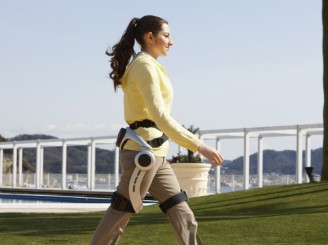Honda prototypes latest walking assist machines

Car manufacturer Honda is prototyping a new range of walking assist machines in the US to help the disabled and elderly.
In a move which sci-fi fans are sure to see as part of the ongoing march towards becoming cyborgs, Honda has put a lot of its cash into mobility robotics research in recent years.
The company is set to demonstrate its prototype walking assist devices at the 2009 Society of Automotive Engineers World Congress event, running in Detroit's Cobo Center from April 20 to 23.
Honda has been developing its walking assist devices for ten years now, carrying out studies which examine and find ways of mechanically recreating the human walk. The same research was used in developing Honda's well-publicised ASIMO humanoid robot.
Strap on and go
The Stride Management Assist is aimed at those who have trouble walking due to weakened leg muscles. Gizmag notes that the "device gathers information about the user's walking motions from hip angle sensors" which then feeds info to a CPU which "calculates how much assistance is needed and when."
Users merely strap on Honda's Stride Management Assist device (weighing in at a mere 6lbs) using a belt around their hips and thighs.
Sign up for breaking news, reviews, opinion, top tech deals, and more.
Honda's heavier and more powerful Bodyweight Support Assist (weighing in at 14lbs) is designed for those users that need maximum assistance to walk (or, of course, the terminally lazy!) and is a simple construction made out of a seat, frame, and shoes, which the user merely steps into.
Stay tuned for more info on commercial release dates, pricing and the like shortly.
Via Gizmag
